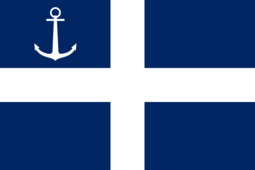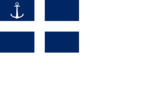Flag of Saint-Baptiste: Difference between revisions
Jump to navigation
Jump to search
(Created page with "{{Infobox flag | Name = Saint-Baptiste | Image = File:Saint-BaptisteFlag.png | Noborder = | Nickname = ''Bleu-et-blanc'' ("Blue-and-white")<br>''Lakwa Blan'' ("The white cros...") |
No edit summary |
||
| Line 20: | Line 20: | ||
| Design2 = A white field with a blue anchor in the hoist and surrounded by a blue border | | Design2 = A white field with a blue anchor in the hoist and surrounded by a blue border | ||
}} | }} | ||
The '''Flag of Saint-Baptiste''' ({{wp|French language|Principean}}: ''Drapeau de la Saint-Baptiste'') is the national flag of [[Saint-Baptiste]]. The current design was adopted in 1947, after the country's independence from [[Blayk]] | The '''Flag of Saint-Baptiste''' ({{wp|French language|Principean}}: ''Drapeau de la Saint-Baptiste'') is the national flag of [[Saint-Baptiste]]. The current design was adopted in 1947, after the country's independence from [[Blayk]], and consists of a blue (often referred to as dark or navy blue) field defaced by a white cross, with a white anchor in the canton. The symbolism of the colours vary,but most popular interpretations denote blue and white as symbolizing either the sea and the sky, or courage and faith. The white cross historically has been seen as a symbol of the feast day of Saint John the Baptist, the island's namesake. | ||
==History== | ==History== | ||
==Other flags== | ==Other flags== | ||
Revision as of 06:36, 6 October 2020
 | |
| Name | Bleu-et-blanc ("Blue-and-white") Lakwa Blan ("The white cross") |
|---|---|
| Use | National flag and civil ensign |
| Proportion | 2:3 |
| Adopted | 1 July 1947 |
| Design | A blue field with a centered white cross and a white anchor in the canton. |
 Variant flag of Saint-Baptiste | |
| Use | State ensign |
| Proportion | 2:3 |
| Adopted | 1 July 1947 |
| Design | A white field with a blue anchor in the hoist and surrounded by a blue border |
The Flag of Saint-Baptiste (Principean: Drapeau de la Saint-Baptiste) is the national flag of Saint-Baptiste. The current design was adopted in 1947, after the country's independence from Blayk, and consists of a blue (often referred to as dark or navy blue) field defaced by a white cross, with a white anchor in the canton. The symbolism of the colours vary,but most popular interpretations denote blue and white as symbolizing either the sea and the sky, or courage and faith. The white cross historically has been seen as a symbol of the feast day of Saint John the Baptist, the island's namesake.